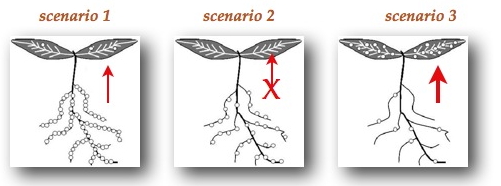What is the impact of heavy metals and radionuclides on plant physiology and metabolism? How to highlight mechanisms adopted by plants to counteract the stress caused by these elements?
The work presented is to assess the influence of uranium speciation on its bioavailability, transfer and distribution in the different compartments of the plant.
In this study, three plant species of agronomic interest (wheat, rapeseed and sunflower) grown in hydroponic conditions were exposed to uranium solutions containing one to two forms of uranium complexes. This study revealed three possible scenarios regarding the behavior of uranium (
Figure):

When exposed to uranium as free uranyl form or as low stable complex (
e.g. uranyl sulphate), plant mainly accumulates uranium in roots, and its transfer to the above ground tissues is limited. In roots, uranium is mainly localized in the epidermic cell layers, the radial transfer being limited (
scenario 1).

When the culture medium contains phosphate, uranium accumulation in roots is moderate and uranium is mainly located in the epidermis of seedling roots. There is no uranium translocation to the shoots (
scenario 2).

In contrast, an exposure to a stable complex of uranyl (
e.g. carbonate or citrate uranyl) reduces the element accumulation in roots, in favours of an effective transfer to the shoots. In this scenario, the distribution of uranium is homogeneous at the tissue scale in roots and leaves (
scenario 3).

Three scenarios describing the behavior of uranium (o) in seedlings grown in hydroponic conditions.
The accumulation and mobilization of uranium in plants also depend on the plant species, and in this context rapeseed seems a promising species for phytoremediation strategies by phytoextraction, since this species is one that transfers and accumulates in its shoots the largest quantity of uranium.
This work received financial support from the Transversal Program for Toxicology (CEA project Plantox_Ura).